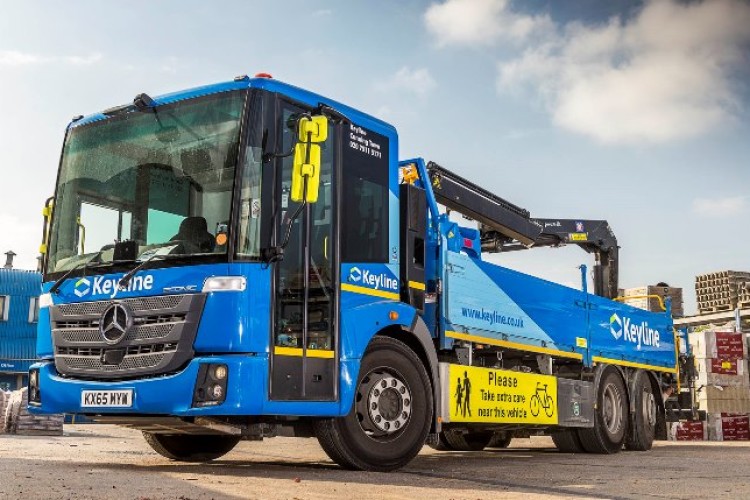There are an estimated 35,000 'off-road' HGVs classed as zero star currently operating on London's roads, and they are reckoned to account for 70% of cyclist fatalities involving HGVs in the last three years. Mayor of London Sadiq Khan wants rid of them.
The Mayor is proposing that only HGVs meeting the new Direct Vision Standard of three stars or above will be allowed on London's roads by 2024.
Transport for London (TfL) has published research by Arup and the University of Leeds that demonstrates the safety benefits of having direct vision from the cab of a lorry rather than relying on mirrors and monitors.
The findings have been published as TfL launches the first consultation into the use of its 'zero to five star' Direct Vision Standard for HGVs operating in the capital. The 12-week consultation runs until 18th April 2017 and aims to identify how the new standard can be best used to reduce road casualties on London's roads.
Under the Mayor's plans, the most dangerous HGVs will be banned from London's streets entirely by January 2020. These HGVs, often 'off-road' lorries, are classed as 'zero-star rated' by the Direct Vision Standard because of the lack of visibility form the cab.
Mayor Sadiq Khan said: “This new research being released today shows how important it is we take bold action to address dangerous and poorly designed lorries operating in the capital. HGVs with poor vision of cyclists, pedestrians and other road users from their cabin should simply not be allowed on London's roads. Every time someone is killed by a lorry on London's roads it is an appalling tragedy. Our ground-breaking Direct Vision Standard will be the first of its kind in the world, and TfL will lead by example by not using any zero-star lorries in its future supply chain.”
Leon Daniels, managing director of surface transport at TfL, said: “Removing lorries that are unsuitable for London's busy roads will improve road safety for all. Our Direct Vision Standard will be key in this and by continuing to engage with the freight industry it can begin to have a positive effect now.

“This won't just increase safety, it will improve how our streets are used. We now know that another benefit of being able to make eye contact with a driver is that it makes pedestrian and cyclists feel safer, and this feeling can make our streets nicer places to live in and visit.”
Arup project manager Dan Evanson said: “This study is aimed at saving lives and avoiding injury. By running the first simulated cognitive tests on drivers of this nature, we have demonstrated that direct visibility is a significant factor in accident avoidance and that reducing HGV drivers' reliance on aids, such as multiple mirrors and in-cab visual display units (VDUs), could significantly improve the safety of our roads. It gives city leaders and policy makers around the world clear evidence that introducing lorries with bigger windows will make city streets safer for cyclists and pedestrians.”
However, the Freight Transport Association (FTA) expressed concern at the proposals. FTA’s head of policy Christopher Snelling said: “Direct vision is clearly a benefit in safety and FTA has advised operators for many years to procure vehicles with the best possible sightlines. However, there are limits to the benefits, which means regulating in this way may not be the best answer to improving safety on our roads. Research for Transport for London (TfL) has shown that no amount of direct vision would help in most cyclist incidents. Technology may prove a better route to minimising casualties as quickly as possible. Following advice from TfL, many operators have invested in cameras and sensors to eliminate blind spots around cabs with apparent success, as the rates of cyclist safety in London interacting with HGVs have improved significantly in recent years. But now that work is to be mostly ignored as it is not accounted for under the DVS.”
He continued: “What London business really needs now is clarity concerning the vehicles which will be affected. Many operators are now in the invidious position of needing to procure vehicles to prepare for the Ultra Low Emission Zone in 2019, and yet cannot do so due to the uncertainty over which vehicles will be allowed on London’s roads in 2020 or 2024.
“Based on the research conducted to date, it is impossible to assess the outcomes of this ruling on many kinds of general distribution HGVs, as well as industrial vehicles such as tippers. We understand more detailed information will be made available before the summer, but industry needs this information before it can assess in full the business challenges involved.
“Vehicle design is a global industry and these discussions are best carried out at a European or UN level. But if London is to proceed with this approach, it needs to be ready to make the plan work for logistics so that small hauliers are not pushed out of business. Above all, the benefits of current and future technological solutions must not be ignored.”
The consultation on the proposals can be found at tfl.gov.uk/vision-standard-phase-one. This consultation will be followed by a second consultation in the summer. Phase 1 will present the technical Direct Vision standard concept and the evidence gathered to date and collect views on the DVS. It will also collect important information on the impacts on stakeholders, like HGV operators, manufacturers and the wider freight industry. This will then be used inform the design of the final scheme proposals.
Got a story? Email news@theconstructionindex.co.uk



